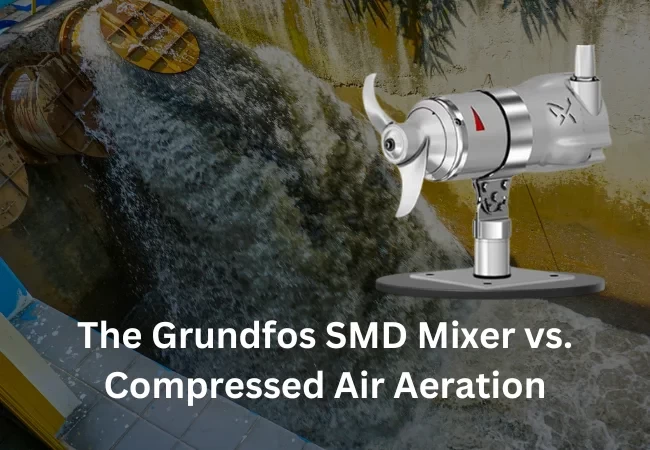
In today’s world, wastewater treatment is not just a necessity; it's a cornerstone of environmental stewardship. Effective and sustainable wastewater treatment processes help preserve our vital water resources, ensuring that clean water remains accessible for all. One of the crucial elements in wastewater treatment is aeration—a process that injects oxygen into wastewater to facilitate the breakdown of organic matter. Traditionally, compressed air aeration systems have been the go-to technology for this purpose. However, Grundfos has introduced a game-changing alternative: the Grundfos SMD mixer. In this blog, we’ll explore how the Grundfos SMD mixer is revolutionizing wastewater treatment and how it compares to traditional compressed air aeration systems.
The Importance of Wastewater Treatment and Aeration
Wastewater treatment is essential for removing pollutants from water before it’s released back into the environment. Treatment plants handle water contaminated by homes, industries, and agriculture, aiming to restore it to a clean, safe state. One critical step in this process is aeration, which involves adding oxygen to the wastewater. This oxygen supports aerobic microorganisms that break down organic pollutants, making the water safer and cleaner.
Efficient aeration is pivotal for effective wastewater treatment. Without adequate aeration, microorganisms cannot thrive, leading to inefficient treatment and potential environmental harm.
Limitations of Conventional Compressed Air Aeration Systems
For decades, compressed air aeration systems have been the industry standard. These systems use diffusers placed at the bottom of treatment tanks to release air bubbles. As these bubbles rise, they create turbulence that mixes the wastewater and promotes oxygen transfer.
Despite their widespread use, compressed air systems have several notable drawbacks:
- High Energy Consumption: Air compressors require substantial energy to operate, resulting in high operational costs and a larger environmental footprint. Energy consumption can be a significant financial burden for wastewater treatment facilities.
- Inefficient Oxygen Transfer: Many air bubbles rise to the surface without adequately mixing with the wastewater, leading to reduced oxygen transfer efficiency. This can create low-oxygen zones within the tank, limiting the effectiveness of the treatment process and impeding the activity of beneficial microorganisms.
- Maintenance Challenges: Diffusers in compressed air systems can become clogged or damaged over time, requiring frequent maintenance and causing potential downtime. Clogged or malfunctioning diffusers further diminish aeration efficiency and overall treatment effectiveness.
Introducing the Grundfos SMD Mixer: A New Era in Aeration
The Grundfos SMD mixer is designed to address the shortcomings of traditional compressed air systems. The Grundfos SMD mixer is a submersible device with a unique side-mounted design that offers a more efficient and sustainable approach to aeration.
The SMD mixer features a powerful motor that drives a specially designed impeller to create a robust jet stream. This jet stream effectively mixes the wastewater throughout the tank, ensuring uniform distribution of oxygenated water. By optimizing energy use and maximizing oxygen transfer, the Grundfos SMD mixer significantly improves the aeration process.
Advantages of the Grundfos SMD Mixer
The Grundfos SMD mixer offers several compelling benefits over conventional compressed air systems:
- Reduced Energy Consumption: The Grundfos SMD mixer requires considerably less energy compared to compressed air systems. Its efficient design and powerful motor ensure effective mixing with lower energy usage, leading to reduced operational costs and a smaller carbon footprint for wastewater treatment plants.
- Enhanced Oxygen Transfer Efficiency: The powerful jet stream produced by the SMD mixer ensures thorough mixing and optimal oxygen distribution throughout the tank. This contrasts with compressed air systems, where many air bubbles may escape to the surface without adequate mixing. The even distribution of oxygenated water promotes better microbial activity and more effective treatment.
- Lower Maintenance Needs: The robust design of the SMD mixer reduces the likelihood of clogging and damage, leading to lower maintenance requirements and less downtime. This not only improves the efficiency of the treatment process but also lowers long-term operational costs.
Conclusion
The Grundfos SMD mixer represents a significant advancement in wastewater treatment technology. By offering reduced energy consumption, enhanced oxygen transfer efficiency, and lower maintenance needs, the SMD mixer stands as a compelling alternative to traditional compressed air aeration systems. As we continue to seek sustainable solutions for environmental protection, the Grundfos SMD mixer is paving the way for more efficient and effective wastewater treatment.
For wastewater treatment facilities looking to improve their processes, adopting Grundfos SMD mixer technology could be the key to achieving greater efficiency, sustainability, and cost savings. Alantech, the leading wastewater treatment plant manufacturer, is proud to deliver Grundfos Pumps in India and the GCC, ensuring top-tier solutions for your wastewater treatment needs.






